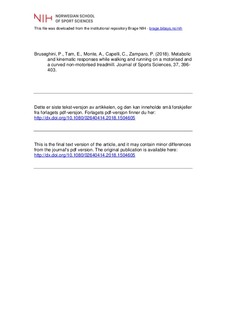| dc.contributor.author | Bruseghini, Paolo | |
| dc.contributor.author | Tam, Enrico | |
| dc.contributor.author | Monte, Andrea | |
| dc.contributor.author | Capelli, Carlo | |
| dc.contributor.author | Zamparo, Paola | |
| dc.date.accessioned | 2019-08-23T10:54:07Z | |
| dc.date.available | 2019-08-23T10:54:07Z | |
| dc.date.created | 2018-10-11T12:30:35Z | |
| dc.date.issued | 2018 | |
| dc.identifier.citation | Journal of Sports Sciences. 2018, 37, 396-403. | nb_NO |
| dc.identifier.issn | 0264-0414 | |
| dc.identifier.uri | http://hdl.handle.net/11250/2609953 | |
| dc.description | I Brage finner du siste tekst-versjon av artikkelen, og den kan inneholde ubetydelige forskjeller fra forlagets pdf-versjon. Forlagets pdf-versjon finner du på tandfonline.com / In Brage you'll find the final text version of the article, and it may contain insignificant differences from the journal's pdf version. The definitive version is available at tandfonline.com | nb_NO |
| dc.description.abstract | The purpose of this study was to assess metabolic and kinematic parameters (contact and flight time, step length and frequency) while walking at the preferred speed (1.44 ± 0.22 m · s−1) and while performing an incremental running test (up to exhaustion) on a motorised treadmill (MT) and on a curved non-motorised treadmill (CNMT). Twenty-five volunteers (24.1 ± 3.4 years; 64.7 ± 11.2 kg) participated in the study. Maximal running speed on MT was significantly larger (P < 0.001) than on CNMT (4.31 ± 0.50 vs. 3.75 ± 0.39 m · s−1) but no differences in heart rate or oxygen uptake were observed at this speed. The energy cost of walking (Cw) and running (Cr) were significantly greater (P < 0.001) on CNMT than on MT (37 and 17%, respectively). No major differences in kinematic parameters were observed at paired, submaximal, running speeds (2.22–3.89 m · s−1) but was systematically larger in CNMT (of about 340 ml · min−1 · kg−1). This systematic difference can be expressed in terms of a larger “equivalent speed” on CNMT (of about 0.42 m · s−1) and should be attributed to factors other than the kinematic ones, such as the belt characteristics (e.g. friction, type of surface and curvature). | nb_NO |
| dc.language.iso | eng | nb_NO |
| dc.subject | curved non-motorised treadmill | nb_NO |
| dc.subject | energy cost of running | nb_NO |
| dc.subject | energy cost of walking | nb_NO |
| dc.subject | kinematics | nb_NO |
| dc.subject | belt friction | nb_NO |
| dc.title | Metabolic and kinematic responses while walking and running on a motorised and a curved non-motorised treadmill | nb_NO |
| dc.type | Journal article | nb_NO |
| dc.type | Peer reviewed | nb_NO |
| dc.description.version | acceptedVersion | nb_NO |
| dc.source.pagenumber | 8 | nb_NO |
| dc.source.journal | Journal of Sports Sciences | nb_NO |
| dc.identifier.doi | 10.1080/02640414.2018.1504605 | |
| dc.identifier.cristin | 1619639 | |
| dc.description.localcode | Seksjon for fysisk prestasjonsevne / Department of Physical Performance | nb_NO |
| cristin.unitcode | 150,31,0,0 | |
| cristin.unitname | Seksjon for fysisk prestasjonsevne | |
| cristin.ispublished | true | |
| cristin.fulltext | postprint | |
| cristin.qualitycode | 1 | |
